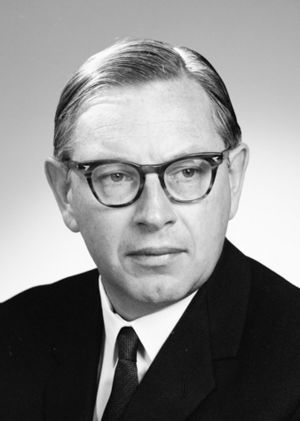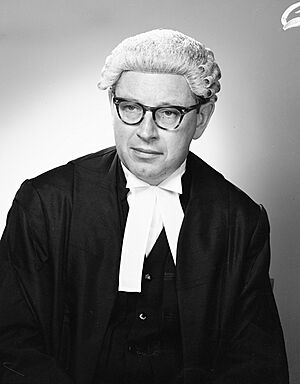Anthony Mason (judge) facts for kids
Quick facts for kids
Sir Anthony Mason
|
|
|---|---|

Mason c. 1968
|
|
| Chief Justice of Australia | |
| In office 6 February 1987 – 20 April 1995 |
|
| Nominated by | Bob Hawke |
| Appointed by | Sir Ninian Stephen |
| Preceded by | Sir Harry Gibbs |
| Succeeded by | Sir Gerard Brennan |
| Justice of the High Court of Australia | |
| In office 7 August 1972 – 6 February 1987 |
|
| Nominated by | William McMahon |
| Appointed by | Sir Paul Hasluck |
| Preceded by | Sir William Owen |
| Succeeded by | Mary Gaudron |
| Judge of the Supreme Court of New South Wales | |
| In office 1 May 1969 – 6 August 1972 |
|
| Nominated by | Robert Askin |
| Appointed by | Sir Roden Cutler |
| Preceded by | New Seat |
| Succeeded by | Robert Hope |
| Personal details | |
| Born | 21 April 1925 Sydney, Australia |
| Relations | Harold Mason (uncle) |
| Education | University of Sydney |
Sir Anthony Frank Mason (born 21 April 1925) is an Australian judge. He was the ninth Chief Justice of Australia, serving from 1987 to 1995. Before that, he was a judge on the High Court starting in 1972. He also served on the Supreme Court of New South Wales.
Contents
Early Life and Education
Anthony Mason was born in Sydney, Australia, on 21 April 1925. He was one of four children. His father, Frank Maxwell Mason, was a surveyor and a veteran of World War I.
Anthony went to Kincoppal and then Sydney Grammar School. He became interested in law because of his uncle, Harold Mason, who was a lawyer.
In January 1944, Mason joined the Royal Australian Air Force (RAAF). He became a flying officer and trained as a navigator. He was discharged in September 1945.
After his military service, Mason studied arts and law at the University of Sydney. He graduated with high honors. He worked for a law firm and also as an assistant to a judge of the Supreme Court of New South Wales.
Legal Career Highlights
Mason became a lawyer in New South Wales. For five years, he taught law at the University of Sydney. Some of his students later became High Court Justices themselves.
In November 1964, at age 39, Mason was named the new Solicitor-General of Australia. This was a very important legal role for the Australian government. He was the first person to hold this job on its own. He served in this role until 1969. During this time, he helped develop Australia's administrative law system.
Judicial Career and Impact
In 1969, Mason became a judge of the Supreme Court of New South Wales. He served there until 1972. That year, he was appointed to the High Court of Australia, which is Australia's highest court. He also received a knighthood.
After 15 years on the High Court, Mason became the Chief Justice of Australia in 1987. He retired in 1995 when he reached the age of 70.
Mason had a big impact on the High Court. He was known for being flexible in how he viewed past legal decisions, called "precedent." He saw it as a guide for fairness rather than a strict rule.
Important Cases During Mason's Time
During the years Mason was Chief Justice, many important cases were decided. Here are a few:
- Cole v Whitfield (1988): This case was about understanding a part of the Australian Constitution (section 92). The court looked at historical records to understand what the Constitution meant.
- Mabo v Queensland (No.2) (1992): This was a landmark decision. The court changed the old idea of terra nullius (meaning "land belonging to no one") in Australian law. It recognized "native title" for Indigenous Australians. This decision led to the Native Title Act 1993.
- Australian Capital Television v Commonwealth (1992) and Nationwide News v Wills (1992): These cases helped establish a "freedom of political communication" in Australia. This freedom means people can talk about politics without too many restrictions.
- Dietrich v The Queen (1992): This case decided that a person accused of a crime has a right to publicly funded legal help if they need it for a fair trial.
After the High Court
After retiring from the High Court, Sir Anthony Mason continued to work in law. From 1997 to 2015, he was a judge for the Hong Kong Court of Final Appeal. He also served as President of the Court of Appeal of the Solomon Islands and was a judge on the Supreme Court of Fiji.
Besides his judicial roles, Mason was also the Chancellor of the University of New South Wales from 1994 to 1999. He also held positions at the University of Cambridge and the National Library of Australia.
Role in the 1975 Australian Constitutional Crisis
In 1975, there was a major political event in Australia known as the 1975 Australian constitutional crisis. On 11 November 1975, the Governor-General, Sir John Kerr, dismissed Prime Minister Gough Whitlam.
Years later, in 2012, Sir Anthony Mason shared his own account of what happened. He confirmed that he had advised Sir John Kerr about the Governor-General's powers. Mason stated that he had told Kerr that the Governor-General could dismiss a Prime Minister who could not get money approved by Parliament.
However, Mason also stressed that he had warned Kerr that the Prime Minister should be told about this intention beforehand. This warning was not followed when Whitlam was dismissed. Mason believed that Sir John Kerr acted according to his duty, except for not warning the Prime Minister.
Honours and Awards
Sir Anthony Mason has received many honours for his contributions:
- Commander of the Order of the British Empire (CBE) in 1969.
- Knight Commander of the Order of the British Empire (KBE) in 1972.
- Companion of the Order of Australia (AC) in 1988.
- Centenary Medal in 2001.
- Grand Bauhinia Medal (GBM) from Hong Kong in 2013.
- He has also received honorary law degrees from many universities around the world.
- In 2018, he was elected a Fellow of the Royal Society of New South Wales.


